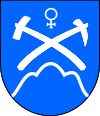Špania Dolina
| Špania Dolina | ||
|---|---|---|
| coat of arms | map | |

|
|
|
| Basic data | ||
| State : | Slovakia | |
| Kraj : | Banskobystrický kraj | |
| Okres : | Banská Bystrica | |
| Region : | Horehrony | |
| Area : | 12.728 km² | |
| Residents : | 215 (Dec. 31, 2019) | |
| Population density : | 17 inhabitants per km² | |
| Height : | 728 m nm | |
| Postal code : | 974 15 | |
| Telephone code : | 0 48 | |
| Geographic location : | 48 ° 48 ' N , 19 ° 8' E | |
| License plate : | BB | |
| Kód obce : | 509035 | |
| structure | ||
| Community type : | local community | |
| Administration (as of November 2018) | ||
| Mayor : | Martina Wilhelmerová | |
| Address: | Obecný úrad Špania dolina 132 97415 Špania dolina |
|
| Website: | www.spaniadolina.sk | |
| Statistics information on statistics.sk | ||
Špania Dolina (until 1927 also "Baňa" in Slovak; German Herrengrund , Hungarian Úrvölgy - until 1882 Urvölgy ) is a municipality in central Slovakia .
It is located high in the mountains, a little off the road north of the town of Banská Bystrica (German Neusohl ) and can only be reached via a mountain road that is sometimes very steep.
The place was first mentioned in writing as Montana in 1263 . The place Piesky (German Sandberg ), incorporated in 1808, belongs to him .
The mining settlement, which has been known since the 13th century, has long been part of the “Copper Neusohl” area. At the end of the 15th century it came into the possession of the Thurzo - Fuggerische Bergbaugesellschaft, from the middle of the 16th century until 1888 it was administered by the Vienna Mining Chamber. At the beginning of the 17th century, however, the unprofitability of mining became apparent and the inhabitants found in lace tatting and production of copper vessels other earning potential.
Culture
Herrengrunder copper vessels were manufactured from the first half of the 17th century to the first decades of the 19th century by home-based work in the Herrengrunder area or more professionally in Neusohl. The production included mugs in particular, but also bowls, cans and cups and other items. Among the cups, the most common form is the hemispherical, also known as the miner's cup or stand-up cup, so-called tumbler, whose name is derived from the verb stumble . See also: Bottlenose dolphin (glass)
Web links
Footnotes
- ↑ The oldest known Herrengrunder copper object shows an engraving with the year 1635, the most recent dating back to 1814. Production was probably stopped between 1829 and 1842.
- ↑ Simone and Peter Huber: About the miracle of the Herrengrund copper vessels on www.mineral.at


